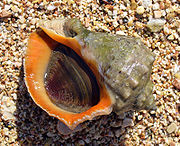
Operculum (animal)
Encyclopedia


Animal
Animals are a major group of multicellular, eukaryotic organisms of the kingdom Animalia or Metazoa. Their body plan eventually becomes fixed as they develop, although some undergo a process of metamorphosis later on in their life. Most animals are motile, meaning they can move spontaneously and...
. Examples include:
- An operculum (gastropod)Operculum (gastropod)The operculum, meaning little lid, is a corneous or calcareous anatomical structure which exists in many groups of sea snails and freshwater snails, and also in a few groups of land snails...
, a single lid that (in its most complete form) closes the apertureAperture (mollusc)The aperture is an opening in certain kinds of mollusc shells: it is the main opening of the shell, where part of the body of the animal emerges for locomotion, feeding, etc....
of the shellGastropod shellThe gastropod shell is a shell which is part of the body of a gastropod or snail, one kind of mollusc. The gastropod shell is an external skeleton or exoskeleton, which serves not only for muscle attachment, but also for protection from predators and from mechanical damage...
when the animal is retracted, and thus protects the internal soft parts of the animal that are not completely covered by the shellGastropod shellThe gastropod shell is a shell which is part of the body of a gastropod or snail, one kind of mollusc. The gastropod shell is an external skeleton or exoskeleton, which serves not only for muscle attachment, but also for protection from predators and from mechanical damage...
. The operculum lies on the top rear part of the foot. When the foot is retracted, the operculum is rotated 180° and closes the shell. - An operculum (fish)Operculum (fish)The operculum of a bony fish is the hard bony flap covering and protecting the gills. In most fish, the rear edge of the operculum roughly marks the division between the head and the body....
, a flap that covers the gills in bony fishes and chimaeraChimaeraChimaeras are cartilaginous fish in the order Chimaeriformes, known informally as ghost sharks, ratfish , spookfish , or rabbitfishes...
s. - The cover that rapidly opens a cnida of a cnidariaCnidariaCnidaria is a phylum containing over 9,000 species of animals found exclusively in aquatic and mostly marine environments. Their distinguishing feature is cnidocytes, specialized cells that they use mainly for capturing prey. Their bodies consist of mesoglea, a non-living jelly-like substance,...
n such as a jellyfishJellyfishJellyfish are free-swimming members of the phylum Cnidaria. Medusa is another word for jellyfish, and refers to any free-swimming jellyfish stages in the phylum Cnidaria...
or a sea anemoneSea anemoneSea anemones are a group of water-dwelling, predatory animals of the order Actiniaria; they are named after the anemone, a terrestrial flower. Sea anemones are classified in the phylum Cnidaria, class Anthozoa, subclass Zoantharia. Anthozoa often have large polyps that allow for digestion of larger...
. The lid may be a single hinged flap or three hinged flaps arranged like slices of pie.
See also
- AptychusAptychusAn aptychus is a type of marine fossil, a hard anatomical structure like a curved shelly plate, which was part of the body of an ammonite. Paired aptychi have, on rare occasions, been found at or within the aperture of ammonite shells....
A structure in ammonites which usually consists of two plates, and which was long thought to be a form of double operculum, but which more recently has been proposed to have been a jaw mechanism. - Aptychus

